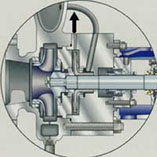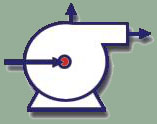 "Multiplicity ought not to be posited without necessity." — Occam's Razor Otherwise stated: |
The Split Flow OptionPump Innovations Reduce Motor Size and Capital CostBy Andrew W. Sloley, Director, The Distillation Group, Inc. Maximizing utilityMaking money in distillation or extraction includes looking at more than just towers and their internals. Engineers must also consider the auxiliary equipment. Often, projects proceed without seeking savings for the auxiliary equipment, resulting in higher operating costs and higher capital costs. Therefore, we should examine processes in their entirety to identify opportunities for capital and operating savings. One opportunity is the use of Split Flow™ technology in pumping services associated with towers. Use of the Split Flow feature reduces the number of pumps required. This simplifies piping and electrical, saves space, reduces the number of pump seals, and can simplify control systems. Split Flow can be applied to overhead systems, pumparounds, pumpdowns and pumped reboiler systems. (See schematic of criteria for use of Split Flow.) One of its features is the ability to produce streams at two different pressures from one pump. Usually, the high-flow, low-head stream returns to the distillation column. The high-head product goes downstream. This paper presents options using Split Flow technology to reduce capital and operating costs and describes how API Standard centrifugal pump designs are modified to incorporate the Split Flow option. Split Flow ApplicationWhere process conditions incorporate high-head, low-flow slipstreams, such as with high-ratio reflux services, common practice is to oversize pumps to envelop the slipstream requirements (Figure 1) instead of using a second smaller pump for the product service (Figure 2, right). A recent innovation incorporates an auxiliary low-flow impeller in an API Standard 610 overhung process pump. This allows the pump to separate the inlet flow into a primary high-flow, low-head discharge and a secondary lower-flow, higher-head discharge. This feature can be incorporated into any standard horizontal or vertical inline pump regardless of size. The only modification necessary to existing API Standard pumps is to the back cover and shaft (Figure 3). This facilitates upgrades and revamp modifications. Seal selection is not restricted and seal life is not compromised as shaft deflection at the seals is within API standards. Most applications will use overhung-type pumps up to 200 hp with slipstreams to 60 gpm using drilled-hole impellers (Figure 4).Two prototype 4 x 6 x 10, 3600 rpm pumps with 60 hp motors and incorporating the Split Flow feature have been operating successfully in hot hydrocarbon fractionator reflux service at the Shell refinery in Martinez, Calif. since June 1996. The conventional pump selection illustrated in Figure 1 would have required 125 hp motors. The Split Flow Pump application, instead, is effectively two pumps-in-one, with each impeller selected for the discrete process requirements of each stream. This Split Flow adaptation saves energy by allowing use of smaller motors when pumps are sized for two process conditions with one discharge flow stream at higher-head and lower-flow than the other (Figure 5). For larger sizes, the Split Flow feature can be incorporated into two-stage, between-bearings, horizontal, radially split case type API Standard 610 pumps. Standard sizes are available in 2 inch through 10 inch with ratings up to 1500 hp and flows up to 4000 gpm for the low-head first stage and 2000 gpm for the higher-head, second-stage discharge. This Big Split Flow adaptation can cut in half the number of pumps required for an installation — thereby saving space, motor kWh, and installation cost. (See figure 6.)
AppendixThe API Standard 610 Foreword, since the January 1981 6th Edition notes: "Energy conservation is of concern and has become increasingly important in all aspects of equipment design, application, and operation. Thus, innovative energy-conserving approaches should be aggressively pursued by the manufacturer and the user during these steps. Alternative approaches that may result in improved energy utilization should be thoroughly investigated and brought forth. This is especially true of new equipment proposals, since the evaluation of purchase options will be based increasingly on total life costs as opposed to acquisition costs alone. Equipment manufacturers, in particular, are encouraged to suggest alternatives to those specified when such approaches achieve improved energy effectiveness and reduced total life costs without sacrifice of safety or reliability."
Andrew W. Sloley is a process engineer specializing in design, troubleshooting, and revamps of distillation equipment and processes for The Distillation Group, Inc. Previously he worked for Exxon Chemical Technology, Glitsch, and other consulting firms. He has a wide range of experience in the petrochemical and refining industries. His more than 70 technical papers cover issues in distillation and product recovery. He holds a Bachelor of Science degree in Chemical Engineering from the University of Tulsa. He can be contacted at 409-764-3975, fax 409-764-1449. |
Article OutlineI. Maximizing utilityII. Split Flow ApplicationIII. Risk aversionIV. API StandardV. Criteria for use of Split Flow
"Energy conservation is of concern and has become increasingly important in all aspects of equipment design, application, and operation. Thus, innovative energy-conserving approaches should be aggressively pursued by the manufacturer and the user during these steps. Alternative approaches that may result in improved energy utilization should be thoroughly investigated and brought forth." — The API Standard 610 Foreword |




